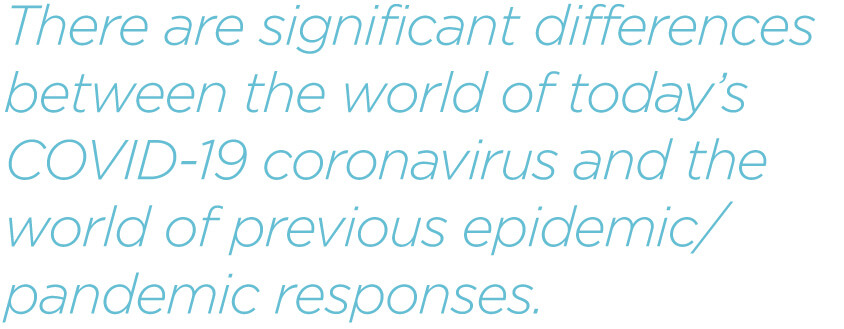Key Elements of Pandemic Readiness
In the face of the COVID-19 (coronavirus) outbreak, business continuity managers are dusting off their pandemic preparedness plans. Many plans have fallen by the wayside in the years since the 2003-2004 SARS outbreak. While now is not the time to rewrite a plan, your organization’s response to the current outbreak requires some business continuity best practices—as well as consistent messaging and direct stakeholder involvement.
Messaging
In his recent book, Call Sign Chaos: Learning to Lead, former U.S. Secretary of Defense James Mattis writes about how in the early stages of any critical event, information is often half-wrong and half-inaccurate. Such is the nature of these events.
Nevertheless, it is important that the crisis team develop a messaging strategy that effectively explains what we know without conjecture, what we are doing about it, and what you can expect next.
In other words: What do I know? Who do I need to tell? Have I told them?
Fully align messaging to that of a credible health authority, such as the U.S. Centers for Disease Control (CDC), the World Health Organization (WHO), or a local equivalent. Connect readers to these sources directly from your message. Identify any gaps between your organization’s policy and the health authority recommendations—and seek to clarify them.
Embrace your Corporate Communication team, if it is not already a member of the crisis Team in your organization. Corporate communications professionals are experts at crafting language that suits your corporate or organizational culture. They can offer precise guidance on the best ways to communicate with your constituents: internal channels, broadcast media, internal social media, and more. They can interpret the intention of your crisis response activity into words or language that convey the meaning to your audience.
Cadence is important because information is perishable in these circumstances. Especially when an event like a pandemic carries on for days or weeks, it is helpful for teams to build a rhythm to messaging that suits the organization—weekly, daily, by exception, or whatever the case may be.
Stakeholder Management
Engage with your key constituents early and often—especially those who lead critical operations. Provide them with a direct connect to your Crisis Team and hear what their priorities are. Establish touchpoints such as short, standing response team calls daily or weekly; or create the expectation that you will follow up with them before/after significant communication updates. Look cross functionally, both vertically and horizontally.
Then establish a set of expectations for how and when to engage as the long-term event unfolds. Pace out a repeating calendar invite twice a week, for 15 minutes, for the next three months, for example. Send out an agenda where every stakeholder gets a minute or two and is welcome to come and go.

Key operational leaders will know the state of the business today, and they intuitively understand what matters most to keep it going. Seek out and trust their guidance.
Functional units carry out all the supporting activities and have unique needs and insights of their own.
For example, the Communications Team can guide outreach to key stakeholders and constituents, as well as the public. HR will help you understand how to make working from home or extended sick leave as a result of quarantine possible within your policies. Finance can make sure that expenses are covered and payments are expedited for crisis response materials.
IT knows the limits of using the hardware, applications, and infrastructure organizations depend on for mobile or remote work. Legal advises on messaging and keeps the risks and liability to the response within tolerance.
Health, Safety, and Environment teams will have access to subject matter experts that can steer technical questions through to decision makers. Procurement and Supply Chain have the relationships and intel on everything related to the resources your organization needs.
Taking stock of these groups’ needs and areas of expertise will lead to a stronger, more unified pandemic response.
Business Continuity: The Good, The Bad, and The Ugly
There are significant differences between the world of today’s COVID-19 coronavirus and the world of previous epidemic/pandemic responses—such as SARS—and this has direct implications for your business continuity planning: good, bad, and ugly.
The Good. Today’s workforce is more mobile and flexible than at any other time in history. In many businesses, employees routinely work from home or have the option and capability to do so. In fact, much modern business infrastructure is already tuned to support this kind of working—and at scale for extended periods of time. If you’re already in this category, then you are in good shape. Make sure your IT partners are in the crisis response tent and can support remote applications, VPNs, and potentially non-organizational hardware.
The Bad. While we gain resilience from our inherent modern mobility, we have sacrificed much of it to complex supply chains that respond in surprising or unpredictable ways to disruption.
When Hurricane Maria hit Puerto Rico in 2017, for example, the capacity to supply saline IV bags to U.S. hospitals and medical facilities—already experiencing intermittent shortages at the time—was critically compromised.
Or, in 2018 when KFC—makers of the famous fried chicken—changed chicken supply distribution partners, the resulting delays impacted delivery and quality at the franchise level causing many restaurants to close for lack of chicken.
In the case of the current coronavirus outbreak, the supply chain implications remain to be fully appreciated. We know that China, most heavily impacted by the outbreak to date, manufactures component parts for major industries from automotive to IT to medicines. We can also expect that transportation and shipping interruptions may complicate normal business operations. Whatever happens, the point is this: get procurement and supply chain on your list of critical stakeholders. Keep critical suppliers engaged.
The Ugly. If your organization’s pandemic plan hasn’t seen the light of day since the SARS outbreak and its sitting next to your box of expired N95 respirator masks, you’re not alone. Let’s be honest—now is not a great time to write a new plan, and personal protective equipment like surgical masks have become strategic commodities.
Instead, you need to focus on people, places, and things. Get a team together and agree on what staff, facilities, and resources will be needed to run only your most critical business processes if things get bad where you are. That can be as simple as listing out your functions, identifying the critical ones, and asking whether those functions and their underlying processes can be managed remotely. For those functions where that’s the case, make sure the people responsible have laptops, VPNs, and any specific IT applications or resources they will need to connect.
Then take an external view and see what dependencies you have outside of your immediate control (like suppliers or distributors). Start clarifying how they will need to work differently for you in abnormal circumstances—and what the limits of that capability may be.
Spend a little extra time and keep checklists of things you are doing—what works and what doesn’t. When the 2020 coronavirus is in the rearview mirror, you will have the makings of an effective and tested business continuity process.
For more information and resources on pandemic preparedness and response, visit the ASIS International topic page: Disease Outbreak Security Resources.
Brendan Monahan is the chair of the ASIS International Crisis Management and Business Continuity Council.
